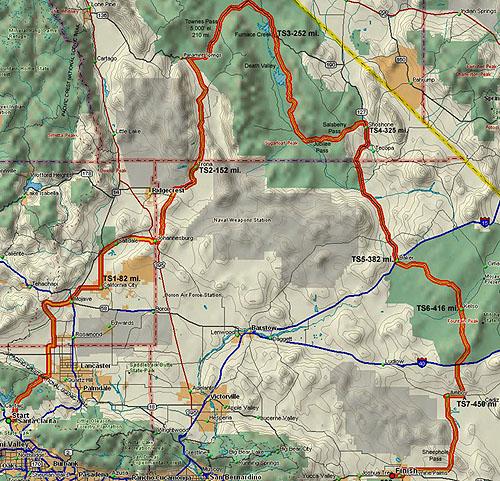 Flicker's 2006 Furnace Creek 508 Experience
Flicker's 2006 Furnace Creek 508 Experience
By Michael Flicker Wolfe
On the night before I was supposed to pedal my bike farther than I ever had before, I couldn't sleep.
I just lay there, next to my sweetie Jennifer, a baseball-sized lump of anxiety congealing in my stomach. Occasionally, I would roll over, or shift, to try to keep myself comfortable. But within an hour of lying down and shutting my eyes, I knew that on that night, sleep would be something that other people did.
Curiously, the fact that my anxiousness was keeping me awake did not add to my anxiousness. I just accepted it, and laid there. I would get up in the morning, and I would deal with the race the best I could in whatever state I arose in. I'm certainly no stranger to embarking on a long ride after a sleepless night. I did my 400k after tossing and turning all night in a bunk room filled with snorers, in a hostel where trains went through the back yard twice an hour. That prior experience gave me some small peace.
So when the alarm went off at five, I sat up, sighed, and rousted my crew. My anxiety had dissipated, and so I was reasonably comfortable (no pre-race jitters), but at the same time, I still felt a complete absence of drowsiness. Recognizing that I only had a limited number of bullets in the caffeine gun, I opted to forgo my customary coffee. I'd save the caffeine boost for later, when I would surely need it.
My crew consisted of Jennifer Rupert (going above and beyond the girlfriend call of duty to see me safely through this), Mark Wolfe (whom I had met once), and Philip Dresser (whom I had never met at all). Phil was in it for the adventure. Jen was there because she cared about me, and for the new experience. I think Mark was there because he feels a lot of pride in Bacchetta bicycles, that he knew that I was a strong rider with a chance to do well, and that with his help, I had a chance to show the world (or, at least some small part of it) what a Bacchetta Aero is capable of. Besides, he was the one who planted the idea to do this back at the Race Across Oregon banquet, and since he got me into this, he darn well was going to help see me through it! On top of that, and perhaps most importantly, I think all three are just kind and generous people.
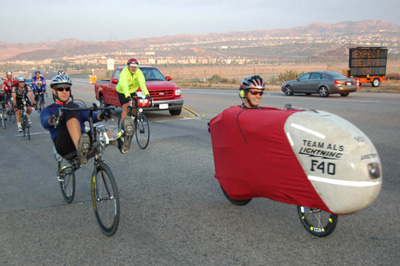
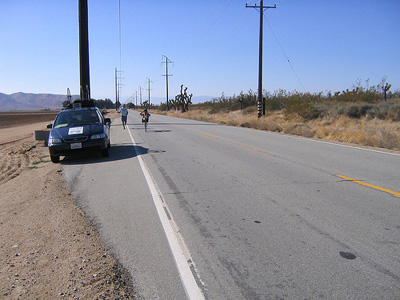
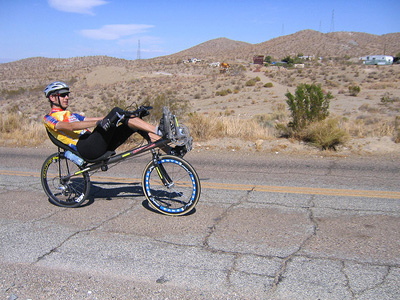
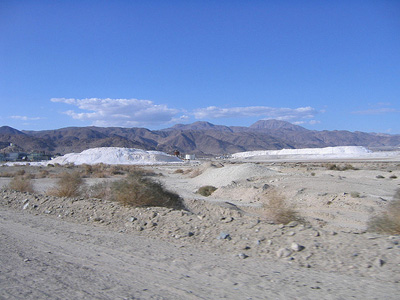
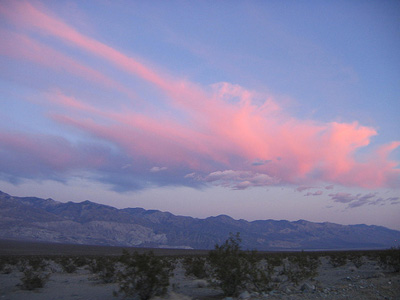
We busied ourselves with last-minute preparations, and then, after grabbing a bite to eat, rolled the bike out to the starting line. I chatted with the folks around me, wishing luck and a strong race to all. I saw my fellow 'bent rider, Tim Woudenberg, and greeted several people from the northwest whom I recognized from brevets that I'd done. Then Chris Kostman came out with a few last-minute reminders, counted down, and all eighty of us rolled out of the parking lot.
I rode with Tim Woudenberg at the start, chatting amiably. We pedalled through the subdivisions around Santa Clarita, staying to the right of the five-lane roads. Then, after a few miles, we took a quick left turn and found ourselves spread out on a narrow, two-lane road that wound up through San Francisquito Canyon. Evidence of human habitation thinned out drastically in that red-brown gorge, reduced mostly to aqueducts snaking up and down the hillsides. I passed a few riders near the bottom, then got passed by a bunch in the middle, and then overtook some more near the top. No matter, it was me versus the course, as far as I was concerned. Just ride strong, finish, and my placing would take care of itself.
At the top of the hill, there was a long line of support vehicles lined up on the side of the road waiting for their riders. I had just run out of Perpetuem, and so looked for my crew, and found them in the middle. I got a fresh bottle and a couple electrolyte tablets, crested the next rise, and then it was miles and miles of downhill for me.
A steep drop for a couple, and then a gentle downgrade across the desert to the base of the windmills climb. I didn't see my crew for a while, and started to get a little worried, as my plain water was running out. I was hauling ass, though, and felt plenty strong, so I kept cruising. Finally, they overtook me, and I got my fresh water bottle. We also switched out wheels for the set of tubulars that John Climaldi had loaned me.
The downward desert gradually turned upward, and the white toothpicks sticking out of the distant hillside became windmills, and I knew that I was on the second mountain section. Up a gentle slope to a creek cut, up the bottom of the creek cut between the turbines to a pass, and then a right turn down the hill towards Mojave. Simple as that. Except that three quarters of the way down the hill, my rear wheel started to handle a little spooky, so I pulled off the road the next time I saw my support vehicle, and sure enough, the tubular was leaking. A quick wheel swap, and I was back on the road, and soon in Mojave.
Mojave was recognizable from a distance by the airliner chop shop that it contains. Fields and fields of shiny jet airplanes put out to pasture. The course took a quick, efficient route around town, and then onto a highway to California City, and the first time station.
On the gradual descent north out of Cali City, I caught Del Scharffenberg, a fellow Oregon Randonneur and a very strong rider. He was clearly suffering; I learned later that he had some bad digestive troubles. He still finished the race, though—he's tough as nails. After a couple miles, right onto Neuralia towards Randsburg. Neuralia featured several miles of rollers that I was still plenty strong enough to jam on, and thus enjoy.
Around this time, Jen started leaning out the window and blowing kisses whenever the van overtook me, which lifted my heart and did me no end of good.
Then I turned off of Neuralia, and onto a road that went up towards Randsburg. I proceeded across what looked like a broad, flat desert toward some hills in the distance. Perspective was playing tricks on me, however—the broad, "flat" desert was the hill. I soon became conscious of the truth, though on some level the visual cue made for a discouraging match to my effort level. But I did finally reach the "hills", and came around a corner to see a run-down little town with a quarry on a peak in the distance: Randsburg. Johannesburg followed close on its heels after a short stretch on a highway, and then I was on Trona Road.
Trona Road was empty, and featured long rollouts followed by upgrades that you'd have to call either baby climbs or monster rollers. I got another flat on this stretch, this time due to a piece of a tire's steel belt, but was able to ride the bike to where my crew was stopped, and so didn't lose any time. This section featured classic high desert landscape with the snow-covered Southern Sierra Nevadas in the distance to the west. I had just started to notice encouragement spray-painted onto the road for "Fast Rabbit" when I came to the crest of the last mega-roller. There was stationed Fast Rabbit's fan club, who gave me encouragement, but all the encouragement I needed came from seeing the miles of descending I had laid out before me.
I screamed down that hillside, and made my right turn. Onto a highway that wound through a shallow basalt canyon—a classic western landscape. Then I came around a corner, and there laid out in front of me was a vista that dropped my jaw. A barren landscape with the bones of the earth in piles, blasted and shattered, and William Blake's "dark satanic mills" in the background. This would be Trona, the second time station.
My crew checked into the time station for me, and refueled while I continued on. We met a bit further down the road to switch wheels—my backup had a 12-27 cassette, while my main wheels had a tighter 11-23. I decided I wanted every bit of mechanical advantage I could get for the impending climb up Townes Pass, so I had them put on the 27. After the wheel swap, the road started going up—that would make this the Trona bump.
I crested the bump, where my crew was waiting to hand me some more water and perpetuem. I was just about to tell them to put a little more space between handoffs so that I could stow the first bottle before I took the second, when once again I was taken aback by the view, this time mid-admonishment. I came around the corner, and there spread below me in all her glory was Panamint Valley.
I zoomed down into the valley and got a good ways through it, when that magic hour of 6 PM rolled around. That meant that my team could go from leapfrog support to close-follow support. And that meant tunes. Having my crew's company, the killer music, the downhill, the cool air, and the beautiful scenery gave me another wind, and I was nigh euphoric when Chris Kostman pulled up alongside for a little interview and to snap some pictures. I felt good on the bike, and I felt strong, and it showed. "Hey Ya" has a tendency to do that to a guy. After he pulled away, I reeled in three or four other riders before I began my climb up Townes Pass in the darkness.
I knew I would be on the pass for a while, so I just kept those cranks turning. I pushed my cadence as much as possible, and when the grade let me, I shifted into a smaller cog in the back. I won't lie, though—I spent a lot of that hill in my 26 in the front and 27 in the back. This let me keep my cadence up and save my legs for the remaining half of the race. The high point of the climb came when Led Zeppelin's "Kashmir" came up on my mix, because it's an awesome rhythm for a climbing song, and it goes on forever. A few miles from the top, I got a bad case of numb/hot feet, and I had to stop. We switched out the inserts in my shoes, and that did a world of good. Two riders who I had passed went by me while I was stopped, but as it turned out, I reeled both in before the top.
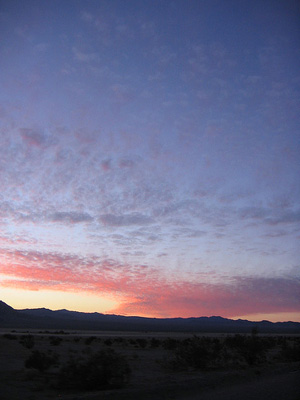
At the top I threw on a jacket, yelled "Geronimo!" and dove into the black. I had 20 miles forward and 5000 feet down to travel. Mark drove the van behind me like a champ, but the descent featured a couple interesting turns and an occasional bump where I didn't have his lights on the road, and just had to rely on my Cateye to reflect off the posts that demarked the edge of the road. Keep the bike pointed between the little white reflected spots, and the headlights would be back on the road in an instant.
I passed Kenny "Fast Truck Gecko" Souza (last year's winner, and the course record holder) on that descent at 50+ miles per hour.
Then, finally, I was down to sea level. Then I was below sea level. I pushed through the easy rollers across the valley floor and down the east side of it to Furnace Creek, where I checked in at the third time station. The seam of my shorts was starting to rub at my crotch the wrong way, so I put on a little bit of chamois butter. (You wouldn't think that a 'bent rider would think to bring such an item, would you? Possibly saved my ride.) Then I was on the road again, and after a few more miles, I got my music again.
The bottom of Death Valley was my playground. My bike just ate up the flat-to-rolling terrain, and I reeled in riders to the strains of Indigo Swing's "Hot Pot Boogie." It was not that I had been bitten by the competition bug. It was just that Death Valley had instilled in me a sense of urgency. I was in my element now, but even at midnight, Death Valley was hot, and I absolutely did not want to get caught still there when the sun rose. I felt like I was tiptoeing through a den of sleeping lions, and I wanted to get as much distance between me and that den as I could while the conditions were good, and that meant turning on the jets.
So I arrived at the bottom of Jubilee pass, the gateway out, with a string of fireflies winding up the valley behind me. The Jubilee-Salsberry Pass double whammy is supposed to be easier than Townes, but I did not find it to be appreciably so. It's basically a single climb, and it's steep, and it's long. A bunch of folks went by me, and I didn't worry about it. Finally, I crested the top, and sailed down the other side. It was a dark, long drop into Shoshone, and drowsiness was starting to soak through my body like spilled wine.
I pulled into Shoshone and checked into Time Station 4. The official there asked me about how the 'bent was doing for me on the course so far, and I gave my boilerplate answer, somehow managing to sound halfway articulate. The official commented that I sounded far more chipper and with it than any other rider he'd seen. It was Potemkin consciousness, though—I was ready to keel over at any second. But the next leg was an easy 54 miles to Baker with no climbs of note, and there was a good stiff wind blowing in the very direction I wanted to go in. There was no telling how long that would last once the sun rose. So I got back on the bike.
The wind lasted for five miles or so before the geography changed, and not long after that I crested Ibex Pass. Then I got a long, long straight descent. This was exactly the worst thing for me at that moment. There was no technical challenge to it and no exertion. What's more, it was still dark, and what I could see of the road was just a vanishing point where the perspective lines joined in the distance. I was sure I was going to doze off and end up at the bottom of a ditch. Finally, the grade leveled off, and I pulled over. It was just getting too dangerous to be on the bike, so I told my crew that I needed 15 minutes to half an hour to close my eyes. I got into the van, and laid my head on Jen's lap.
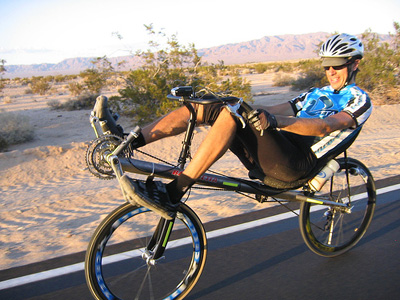
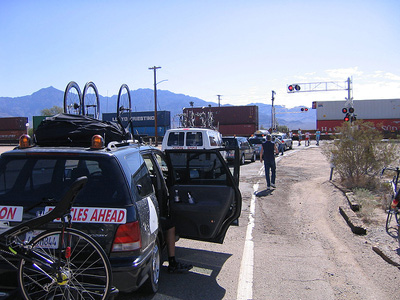
Twenty minutes later, I was up, and feeling much more alert, if still somewhat fatigued and sluggish. I limped into Baker under the rising sun, and pushed on while the crew checked in for me and gassed up. The road leading out of Baker was pretty crappy, and I wasn't inspired to impose my will on it, so I pushed along at maybe 70% or so. I knew that this was just a low point; I had had several in the race so far. The first one (around the Randsburg climb) really worried me, because I was scared that even though it wasn't bad yet, that things would only get worse. That turned out not to be the case—things actually got a lot better at times. But I knew that part of the problem was low energy, and to get more energy, I needed to consume more energy. So I stepped up on taking in the Hammer Gel and Perpetuem. Then my crew caught up, and turned on the tunes. And the long hill seemed to even out a bit. And as I knew I would, I started to feel better.
After something like five false summits, I finally crested the climb up out of Baker, and started descending down to Kelso on the crappiest pavement I hope to never descend on again. I pulled into town, only to discover a queue at a railroad crossing, with the guardrails down. Some thoughtful engineer put a railroad siding right across the only road crossing for 20 miles in either direction! This was almost too much to handle. I was running on mental fumes at that point, but as long as I could keep pedaling, I knew that I would finish the race. Now I couldn't even do that. My heart nearly broke, but then I sat down and just made the most of it by taking another 20 minute nap, and by getting ahead in my calorie intake.
Finally, after an hour and twenty minutes, the damn train left, and the guard rails went up, and we could cross. I let the other riders waiting there go first, because I was in slow and steady mode. There were just two more climbs left, and that was all the competition I needed. The climb out of Kelso went well, though—I felt strong and the grade was short and shallow by the standards of the course. I crested near the microwave tower, wound around at the top through some snarling basalt rock formations, and then began a long descent down to the final time station before the finish line, just outside of Amboy. It was a long, straight descent that I averaged maybe 40 mph on, and it still took forever it was so long. It was another one where I had to blink a couple times once or twice to keep myself awake. It was long!
From the time station, I turned right and jetted down to Amboy, a decrepit little hovel in the middle of the desert. In Amboy, I turned south toward Sheephole Summit. One last climb. It was really heating up. The terrain to my left appeared to be a dry lake bed, and to my right, the desert hills stretched out as far as I could see. Just one more climb. It was getting very difficult to take it a mile at a time. I knew the top of that hill would be a huge relief, and that finishing this climb would mean beginning the home stretch. The road wound around the shoulder of the hill, and I could see where it stretched up the broad, featureless desert slope. I just kept pedaling. My feet were in agony. I stopped for a break, and Jen rubbed them to try to get some circulation back into them. I got back on the bike. The grade got much steeper, but it looked like it was going to crest. No. False summit. But maybe around that next bend...? And there it was. The valley that I would take all the way into Twentynine Palms, the goal of all this travail, laid out before me. Mark played "29 Palms" by Robert Plant over the P.A., and then I pointed the bike downhill for my final descent.
The ride the rest of the way into Twentynine Palms was indeed the home stretch. All of the aches and ailments that had accumulated on my ride were threatening to reach a crescendo, the sun was going down and shining right into my eyes, and the road had the crappiest surface yet. And then my left knee cramped up. I would be god damned before I gave up though; I eased off on the left leg, perfectly willing to go in on one leg if need be. As it turned out, it wasn't necessary. There was the town on the horizon, then a left turn, and then a right on 29 Palms Highway, then up one last sucker-punch hill, and then the finish line, and glory.
For more photos click here